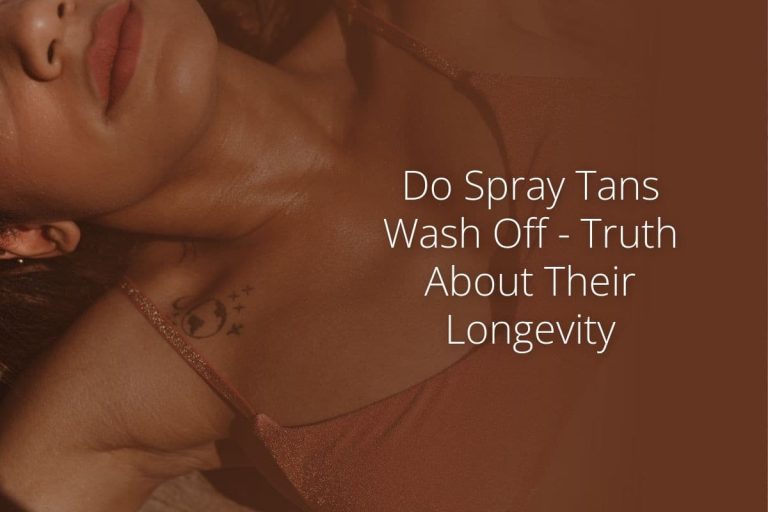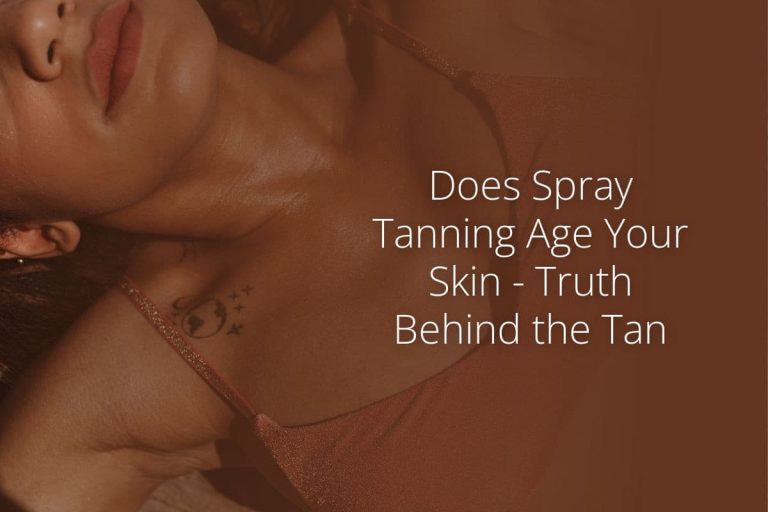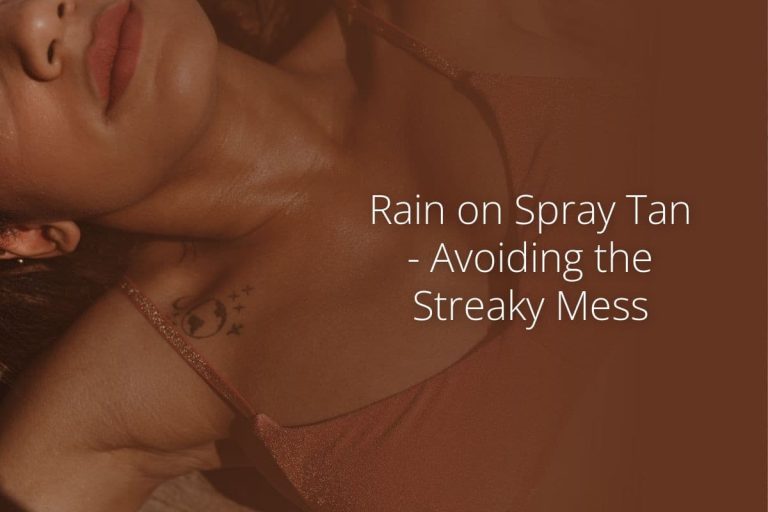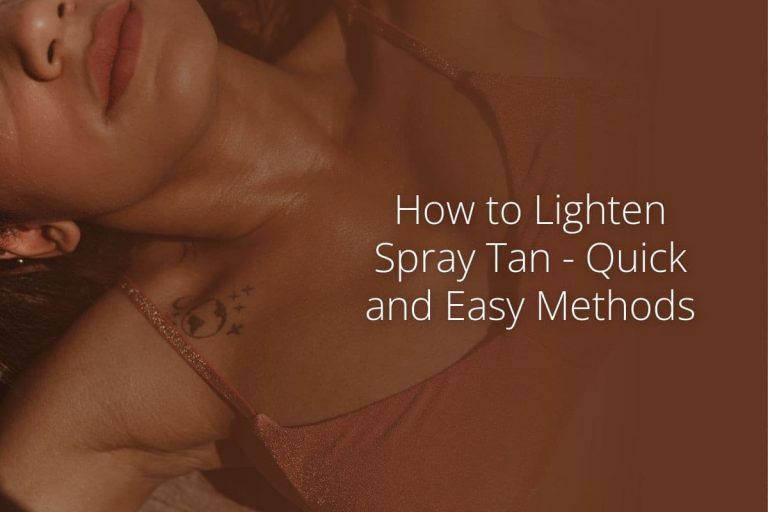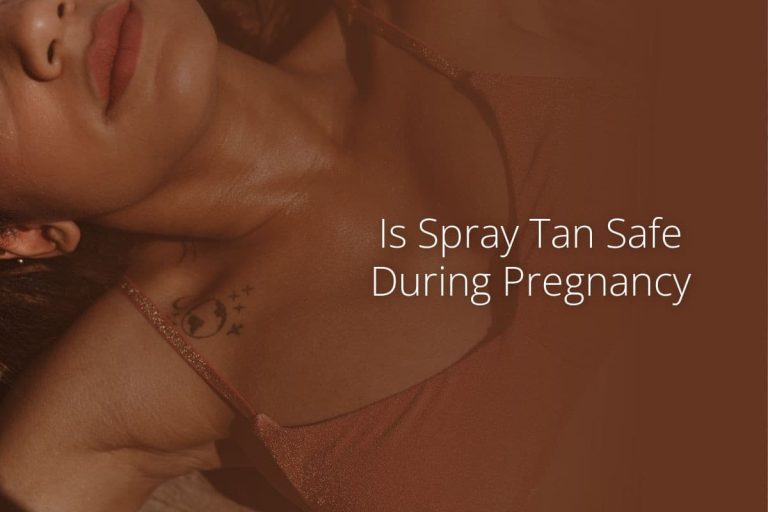
Spray tans – the go-to solution for tanners seeking a bronzed complexion. We all have heard about the convenience and effectiveness of this wonderful method. But here’s the burning question: are spray tans bad for you? With commercial spray options flooding the market, it’s essential to understand their potential risks and benefits for skin tone, skin cancers, and skin aging before diving into that golden hue.
To address these concerns, we’ll explore the various aspects of spray tanning, including its drawbacks and advantages. So, if you’re curious about whether these tanners can harm your skin or offer a safe way to achieve that enviable tan, keep reading.
This article delves into the safety concerns surrounding spray tanning, providing insights into what you need to know.
Understanding the Risks of Spray Tanning
Spray tans have become a popular alternative for tanners concerned about the risks of sunbathing or using tanning beds. This method involves applying chemical formulas to the skin, which react with the outermost layer to create a temporary tan. While spray tanning offers a quick and convenient way to achieve that sun-kissed look, it’s important to understand the potential risks involved, as highlighted by numerous studies.
The main concern for tanners is the risk of allergic reactions to the ingredients in spray tanning solutions. Studies have shown that dihydroxyacetone (DHA) and various additives are common culprits. Allergies can cause redness, itching, swelling, or hives on the skin. In severe cases, individuals may experience difficulty breathing or anaphylaxis. Therefore, it is essential to find a safe alternative.
To minimize the chances of an allergic reaction to tanning products, it’s crucial to be aware of any allergies or sensitivities you may have before getting a spray tan at tanning salons. Consult with your dermatologist if you’re unsure about certain ingredients or if you’ve had previous reactions to similar substances. Performing a patch test on a small area of skin can help identify any adverse reactions before applying the solution for sun tanning all over your body.
Proper preparation and aftercare are essential for minimizing potential risks associated with spray tanning for tanners. Before your session, exfoliate your skin thoroughly to remove dead cells and ensure an even application for tanners. Pay attention to areas prone to dryness such as elbows and knees for tanners.
During the session, protect your skin from aging and damage caused by sun tanning by using protective creams or barriers provided by professionals at the salon. It’s advisable to wear disposable undergarments or nose plugs if available for sunless tanning.
Afterward, moisturize your skin regularly to maintain hydration and prolong the life of your sun tanning. Avoid excessive sweating or prolonged exposure to water immediately after getting a spray tan as this can affect the longevity of the color. Don’t forget to follow the sun tanning tips from Malerich for best results.
While spray tanning does not expose you to harmful UV rays like sunbathing or using tanning beds, it’s important to note that it provides no protection against UV radiation. UV exposure is a major risk factor for skin cancer, and relying solely on spray tans for a tan complexion may lead to a false sense of security. It’s crucial to continue practicing sun safety measures such as wearing sunscreen and seeking shade when necessary to protect against the risks of malerich.
In rare cases, individuals may experience contact dermatitis due to an irritant or allergic reaction from the malerich solution. This can cause redness, itching, and discomfort on the skin. If you notice any adverse reactions after getting a malerich spray tan, consult with a healthcare professional for proper evaluation and treatment.
Safety Concerns: Potential Health Risks
While generally considered safe, spray tanning does come with some health risks that should be taken into consideration. It’s important to be aware of these potential concerns and take necessary precautions to protect your health.
One of the main ingredients in most spray tan solutions is DHA (dihydroxyacetone). While it is approved by the FDA for external use, inhaling or ingesting DHA can be harmful. This means that during the application process, it’s crucial to protect your eyes, nose, and mouth to avoid any unnecessary exposure. Failure to do so can result in eye irritation and respiratory issues.
Research suggests that repeated exposure to DHA may have long-term health effects. Recent studies have raised questions about the potential risk of developing certain conditions after prolonged use of spray tans. Although more research is needed to fully understand the extent of these risks, it’s essential to consider the possible consequences before deciding on regular spray tanning as a beauty routine.
Furthermore, there are concerns regarding the chemicals present in spray tan solutions. Some individuals may have sensitivities or allergies to certain ingredients commonly found in these products. It’s crucial to check the list of ingredients carefully and consult with a dermatologist if you have any known allergies or skin conditions.
Another factor worth noting is the potential risk of damage from UV radiation during the drying process when using UV light booths for spray tans. While this method provides a quick way to dry your tan, it exposes your skin to UV radiation similar to that emitted by tanning beds. Prolonged exposure can increase your risk of skin cancer and other related conditions.
To minimize potential risks associated with spray tans, there are a few alternatives you can consider:
- Use self-tanning lotions or creams: These products contain DHA, making them a safe alternative to commercial spray tans that may pose risks of inhalation or ingestion.
- Opt for professional airbrush tanning: This method involves an experienced technician applying the spray tan solution using an airbrush, ensuring better control and minimizing the risk of inhaling or ingesting the product.
- Consider natural alternatives: Some individuals choose to use natural ingredients like cocoa powder or coffee grounds to achieve a temporary bronzed look. While these methods may not provide as long-lasting results as spray tans, they eliminate concerns about chemicals and potential health risks.
Pregnancy and Spray Tanning: Is it Safe?
Pregnant women often question whether it’s safe to get a spray tan during pregnancy. While maintaining a healthy appearance is important, the well-being of both the mother and the baby takes precedence. Limited research suggests that external use of DHA-based products is likely safe for pregnant women, but it’s crucial to consult with your healthcare provider before getting a spray tan while pregnant.
Taking necessary precautions when using fake tan becomes even more essential. Here are some key points to consider when applying fake tan.
Consult with Your Healthcare Provider
Before indulging in any beauty treatments during pregnancy, including spray tanning, it’s vital to seek guidance from your healthcare provider. They can provide personalized advice based on your specific circumstances. Although limited research indicates that DHA-based products are generally safe for external use during pregnancy, every woman’s situation is unique. Hence, consulting with your doctor will help you make an informed decision.
Potential Risks
While spray tans are generally considered safe for pregnant women, there are still potential risks involved. Some individuals may experience allergic reactions or skin irritations due to the chemicals present in certain tanning solutions. Moreover, inhaling excessive amounts of spray tan mist could be harmful as well. It is essential to ensure proper ventilation in the tanning booth or room to minimize inhalation exposure.
Protective Gear
To further reduce any potential risks associated with spray tans during pregnancy, wearing protective gear is highly recommended. Consider using items such as nose filters or masks to prevent inhaling excessive amounts of tanning solution particles. Protecting sensitive areas like the eyes and lips with goggles and lip balm can help avoid irritation.
Alternatives
If you decide that spray tanning may not be suitable for you during pregnancy or if you simply prefer avoiding any potential risks altogether, there are alternative options available:
- Gradual self-tanners: These lotions or creams allow you to build up a tan gradually over time. They are typically considered safe for pregnant women.
- Bronzing powders or makeup: Applying bronzing powders or makeup can provide a temporary tanned appearance without the need for chemical exposure.
While maintaining your desired appearance is important, it’s essential to prioritize the safety and well-being of both yourself and your baby during pregnancy. By consulting with your healthcare provider and taking necessary precautions, you can make an informed decision about whether spray tanning is right for you.
Dihydroxyacetone (DHA) in Spray Tans: What to Know
DHA, also known as dihydroxyacetone, is an FDA-approved color additive commonly found in self-tanners and spray tan solutions.Spray tans have become a popular choice. But what exactly is DHA and how does it work? Let’s dive into the details.
During the application process, DHA reacts with amino acids on the surface of your skin. This reaction creates a temporary dye that gives your skin a bronzed appearance. It’s important to note that DHA only affects the top layer of your skin and doesn’t penetrate deeper into the body.
The concentration of DHA in spray tan solutions can vary, which directly impacts both the intensity and longevity of your tan. Higher concentrations generally result in a darker tan that lasts longer before fading away. However, it’s essential to find a balance that suits your desired outcome without going overboard.
While spray tans are generally considered safe for external use, there are concerns about inhaling DHA during application. Although research on this topic is limited, taking precautionary measures such as wearing protective eyewear and nose filters can help minimize any potential risks associated with inhalation.
Understanding how DHA works allows you to make informed decisions. Here are some key points to keep in mind:
- Temporary Coloration: The color produced by DHA is not permanent and gradually fades away as your skin naturally exfoliates over time. On average, a spray tan can last anywhere from 5-10 days before requiring touch-ups or reapplication.
- Patch Test: Before getting a full-body spray tan, it’s recommended to do a patch test on a small area of your skin first. This helps determine if you have any adverse reactions or allergies to DHA.
- Pre-Tan Preparation: To ensure an even and long-lasting tan, exfoliating your skin before a spray tan session is crucial. Removing dead skin cells helps create a smooth canvas for the DHA to adhere to, resulting in a more uniform color.
- Post-Tan Care: After getting a spray tan, it’s important to moisturize regularly to prolong its lifespan. Dry skin can cause the tan to fade faster, so keeping your skin hydrated helps maintain that sun-kissed look for as long as possible.
- Gradual Build-Up: If you’re new to spray tanning or prefer a subtle glow, opting for gradual self-tanning lotions or mists with lower concentrations of DHA can be a great starting point. These products allow you to build up your desired shade gradually while minimizing the risk of an overly dark or unnatural-looking tan.
Debunking Common Myths About Spray Tans
Spray tans have become increasingly popular as a safer alternative to traditional tanning methods. However, there are several misconceptions surrounding spray tans that need to be addressed.
Myth: Spray tans cause skin cancer like sun exposure or tanning beds.
One prevailing myth about spray tans is that they can lead to skin cancer, similar to the risks associated with sun exposure or using tanning beds. However, this is simply not true. Unlike UV radiation from the sun or tanning beds, spray tans do not expose your skin to harmful rays that can potentially damage your DNA and increase the risk of skin cancer.
Spray tan solutions contain an active ingredient called Dihydroxyacetone (DHA), which reacts with the proteins in the outermost layer of your skin to produce a temporary color change. This chemical reaction does not penetrate beyond the surface layer and does not pose any significant health risks. So rest assured, you can achieve a golden glow without worrying about increasing your chances of developing skin cancer.
Myth: Spray tans provide SPF protection against harmful UV rays.
Another common misconception is that spray tans offer protection against harmful UV rays just like sunscreen does. While it’s true that some self-tanners may contain added SPF ingredients, it’s important to note that these products typically provide minimal sun protection compared to dedicated sunscreen lotions.
Spray tan solutions primarily work by darkening the appearance of your skin through pigmentation rather than providing a physical barrier against UV radiation. Therefore, it is crucial to continue using broad-spectrum sunscreen with an appropriate SPF rating when spending time outdoors, even if you have a spray tan. Don’t rely solely on your tan for sun protection; make sure you prioritize proper sun care practices.
Myth: Spray tans will permanently stain your clothes or bedding.
Many people worry that spray tans will leave unsightly stains on their clothes or bedding. However, this is yet another myth that needs debunking. While it’s true that some initial color transfer may occur immediately after getting a spray tan, the solution used in professional salons is typically formulated to minimize any potential staining.
To prevent any unwanted color transfer, it is recommended to wear loose-fitting clothing immediately after your spray tan session and avoid contact with light-colored fabrics until you have showered off the excess solution. By following these simple precautions, you can enjoy your tan without having to worry about ruining your favorite clothing or bedding.
Debunking these myths helps separate fact from fiction. It’s important to understand the truth behind these misconceptions so that you can make informed decisions about how to achieve a beautiful, sun-kissed glow without compromising your health or worrying about potential side effects. Embrace the benefits of spray tans and enjoy a safe and natural-looking tan all year round!
Comparing Spray Tans to Tanning Beds and Real Tans
Unlike natural sun exposure or tanning beds, spray tans do not expose the skin to harmful UV radiation. While a spray tan provides temporary color, it does not offer the same benefits as a real tan. The risks associated with UV exposure are well-documented, making spray tanning a safer alternative. Understanding the differences between these methods can help you make an informed choice for your skin.
No Harmful UV Radiation
One of the main advantages of spray tans is that they do not subject your skin to harmful UV radiation like natural sun exposure or tanning beds. When you spend time in the sun or use a tanning bed, your skin is exposed to ultraviolet (UV) rays that can damage DNA and increase the risk of skin cancer. Spray tans, on the other hand, rely on Dihydroxyacetone (DHA), a chemical that reacts with dead cells on the surface of your skin to produce a temporary bronzed appearance without any UV exposure.
Temporary Color vs. Real Tan
While spray tans can give you an instant faux glow, it’s important to note that they only provide temporary color. The pigments from spray tan solutions adhere to the outermost layer of your skin and gradually fade away as these dead cells are shed naturally over time. In contrast, real tans occur when melanin production increases in response to UV radiation, resulting in a longer-lasting change in skin tone.
Safer Alternative
Given the well-documented risks associated with UV exposure from sunlight and tanning beds, many people turn to spray tanning as a safer option for achieving a bronzed look. According to research conducted by dermatologists, excessive UV radiation damages collagen fibers and elastic tissue in the skin, leading to premature aging signs such as wrinkles and sagging. Repeated sunburns or prolonged tanning bed use can significantly increase the risk of developing skin cancer. Spray tans offer a way to avoid these risks while still enjoying a sun-kissed appearance.
Making an Informed Choice
Understanding the differences between spray tans, tanning beds, and natural tanning can help you make an informed choice for your skin. Consider factors such as convenience, longevity of color, potential health risks, and personal preferences. If you prefer a quick and temporary tan without UV exposure, spray tans may be the ideal option for you. On the other hand, if you enjoy spending time in the sun or want longer-lasting results, natural sun tanning or using a tanning bed might be more suitable.
Conclusion
In conclusion, spray tanning offers several benefits for those looking to achieve a sun-kissed glow without the harmful effects of UV radiation. By understanding the risks associated with spray tanning and taking necessary precautions, you can enjoy healthier skin and long-lasting results.
While there are potential health risks associated with spray tanning, such as allergic reactions or inhalation concerns, these can be minimized by following safety guidelines and choosing reputable salons that prioritize customer safety. It’s important to note that pregnant individuals should consult their healthcare provider before undergoing spray tanning treatments.
The key ingredient in spray tans, Dihydroxyacetone (DHA), is generally considered safe for topical use. However, it’s essential to avoid ingestion or inhalation of DHA during the application process. By carefully following instructions and seeking professional advice if needed, you can ensure a safe experience.
It’s crucial to debunk common myths surrounding spray tans. Contrary to popular belief, they do not provide protection against UV rays or prevent sunburns. Comparing spray tans to both tanning beds and natural sun exposure reveals that they offer a safer alternative without the risk of skin damage caused by harmful UV radiation.
To make an informed decision about whether spray tans are right for you, consider your personal preferences and priorities. Keep in mind that individual experiences may vary, so it’s always helpful to read reviews or seek recommendations from trusted sources before trying out a new salon or product.
Remember, maintaining healthy skin goes beyond just achieving a tan. Regularly moisturizing your skin and protecting it from excessive sun exposure are essential for long-term skin health. If you have any concerns about your skin or overall well-being, consult with a dermatologist who can provide personalized advice based on your specific needs.
So go ahead and embrace the benefits of spray tanning – healthier skin and long-lasting results await you!
FAQs
Will spray tanning make me look orange?
Spray tans have come a long way in recent years, and the risk of looking orange is minimal when applied correctly. Opting for a reputable salon and discussing your desired shade with the technician can help ensure natural-looking results.
How long will my spray tan last?
The longevity of a spray tan depends on various factors, such as your skin type, aftercare routine, and the quality of the product used. On average, a spray tan can last anywhere from 5 to 10 days before gradually fading.
Can I still go swimming with a spray tan?
While it’s generally safe to swim with a spray tan, prolonged exposure to chlorine or saltwater may cause the color to fade more quickly. To extend the life of your tan, consider using waterproof sunscreen and moisturizing after swimming.
Will a spray tan protect me from sunburns?
No, spray tans do not provide any protection against UV rays. It’s important to continue practicing sun safety measures such as wearing sunscreen and seeking shade when necessary to prevent sunburns and skin damage.
Can I get a spray tan if I have sensitive skin?
Individuals with sensitive skin may be more prone to allergic reactions or irritation from certain ingredients in spray tans. It’s advisable to perform a patch test beforehand or consult with an allergist or dermatologist if you have concerns about potential reactions.
Are there any age restrictions for getting a spray tan?
Most reputable salons require individuals under 18 years old to have parental consent before receiving a spray tan. It’s always best to check with the specific salon regarding their policies on age restrictions.
Can I apply makeup over my spray tan?
Yes, you can apply makeup over your spray tan once it has fully developed. However, keep in mind that heavy makeup application or excessive rubbing may cause the tan to fade more quickly.
How often can I get a spray tan?
The frequency of spray tans depends on personal preference and how well your skin retains the color. It’s generally recommended to wait at least a week between sessions to allow for natural fading and to avoid an overly dark or uneven appearance.


